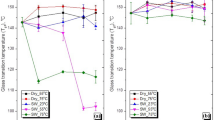Abstract
Glass fiber-reinforced epoxy composite pipes are used in submarine applications, natural gas, and oil transportation lines, transfer of chemical liquids. Especially in the transport of pressurized fluids, changes in the strength of the pipes are important. The corrosive effect of seawater has an important impact on the mechanical properties of the composite material. In particular, the alteration in hoop tensile strength is one of the issues to be investigated. In this experimental study, glass fiber-reinforced epoxy resin composite pipes were exposed to the seawater aging process for different time periods (1, 2 and 3 months) in order to determine the effects of seawater absorption behavior on hoop tensile strength. Hoop tensile strength test was realized in accordance with ASTM D2290 Procedure A. As a result of this work, the average tensile strength values of the composite pipes decreased as the waiting times in seawater increased.






Similar content being viewed by others
References
M. Kara, M. Uyaner, A. Avci, A. Akdemir, Effect of non-penetrating impact damages of pre-stressed GRP tubes at low velocities on the burst strength. Compos. B Eng. 60, 507–514 (2014)
M. Uyaner, M. Kara, A. Şahin, Fatigue behavior of filament wound E-glass/epoxy composite tubes damaged by low velocity impact. Compos. B Eng. 61, 358–364 (2014)
K. Alderson, K. Evans, Low velocity transverse impact of filament-wound pipes: Part 1: damage due to static and impact loads. Compos. Struct. 20(1), 37–45 (1992)
E.S. Rodriguez, V.A. Alvarez, P.E. Montemartini, Failure analysis of a GFRP pipe for oil transport. Eng. Fail. Anal. 28, 16–24 (2013)
E. Mahdi, A.M.S. Hamouda, B.B. Sahari, Y.A. Khalid, Effect of hybridisation on crushing behaviour of carbon/glass fibre/epoxy circular–cylindrical shells. J. Mater. Process. Technol. 132(1–3), 49–57 (2003)
R.K. Watkins, L.R. Anderson, Structural Mechanics of Buried Pipes (CRC Press, Boca Raton, 1999)
H.F. Kayıran. Farklı ortam koşullarına maruz hibrit kompozit plakalarda burkulma davranışının incelenmesi., in Fen Bilimleri Enstitüsü Makine Mühendisliği. University of Suleyman Demirel Isparta, Turkey (2018)
H. Kanlıoğlu. Environmental effects on pin-loaded laminated composites. DEÜ Fen Bilimleri Enstitüsü (2009)
J.F. Wellicome, R.A. Shenoi, Composite Materials in Maritime Structures: Fundamental Aspects (Cambridge University Press, Cambridge, 1993)
W.S. Chow, Water absorption of epoxy/glass fiber/organo-montmorillonite nanocomposites. Express Polym. Lett. 1(2), 104–108 (2007)
N.M. Barkoula, A. Paipetis, T. Matikas, A. Vavouliotis, P. Karapappas, V. Kostopoulos, Environmental degradation of carbon nanotube-modified composite laminates: a study of electrical resistivity. Mech. Compos. Mater. 45(1), 21–32 (2009)
A.R. Bunsell, B. Harris, Hybrid carbon and glass fibre composites. Composites 5(4), 157–164 (1974)
R.K. Nayak, B.C. Ray, Influence of seawater absorption on retention of mechanical properties of nano-TiO2 embedded glass fiber reinforced epoxy polymer matrix composites. Arch. Civ. Mech. Eng. 18(4), 1597–1607 (2018)
C.J. Huang, S.Y. Fu, Y.H. Zhang, B. Lauke, L.F. Li, L. Ye, Cryogenic properties of SiO2/epoxy nanocomposites. Cryogenics 45(6), 450–454 (2005)
E.P. Gellert, D.M. Turley, Seawater immersion ageing of glass-fibre reinforced polymer laminates for marine applications. Compos. Part A Appl. Sci. Manuf. 30(11), 1259–1265 (1999)
A.M. Visco, N. Campo, P. Cianciafara, Comparison of seawater absorption properties of thermoset resins based composites. Compos. Part A Appl. Sci. Manuf. 42(2), 123–130 (2011)
R. Pal, H.N.N. Murthy, M. Sreejith, K.R.V. Mahesh, M. Krishna, S.C. Sharma, Effect of laminate thickness on moisture diffusion of polymer matrix composites in artificial seawater ageing. Front. Mater. Sci. 6(3), 225–235 (2012)
P. Davies, Y.D. Rajapakse, Durability of Composites in a Marine Environment, vol. 208 (Springer, Berlin, 2014)
M. Bazli, H. Ashrafi, A.V. Oskouei, Effect of harsh environments on mechanical properties of GFRP pultruded profiles. Compos. B Eng. 99, 203–215 (2016)
L. Wu, K. Murphy, V.M. Karbhari, J.S. Zhang, Short-term effects of sea water on E-glass/vinylester composites. J. Appl. Polym. Sci. 84(14), 2760–2767 (2002)
A. Kootsookos, A.P. Mouritz, Seawater durability of glass-and carbon-polymer composites. Compos. Sci. Technol. 64(10–11), 1503–1511 (2004)
M. Belevi, G. İnançer, Darbe ve ortam şartlarının kompozit malzemelerin mekanik özelliklerine etkileri. Makine Teknolojileri Elektronik Dergisi 4, 19–31 (2008)
H. Gu, Behaviours of glass fibre/unsaturated polyester composites under seawater environment. Mater. Des. 30(4), 1337–1340 (2009)
M. Sari. Sea water effect on composite pipes subjected to impact loading. Dokuz Eylul University: Izmir, Turkey (2010)
G. Örçen, M. Gür. Cam Fiber Takviyeli Dokuma Epoksi Kompozit Prepreglerin Mekanik Özellikleri Üzerinde Çevre Şartlarının Etkisi (2011)
R. Karakuzu, İ.C. Çalık, M.E. Deniz, Tabakalı Kompozit Plakların Darbe Davranışı Üzerine Deniz Suyu Etkisinin Araştırılması. Batman Üniversitesi Yaşam Bilimleri Dergisi 7(2/2), 1–13 (2017)
E. José-Trujillo, C. Rubio-González, J.A. Rodríguez-González, Seawater ageing effect on the mechanical properties of composites with different fiber and matrix types. J. Compos. Mater. 53(23), 3229–3241 (2019)
M. Kara, M. Kırıcı, Effects of the number of fatigue cycles on the impact behavior of glass fiber/epoxy composite tubes. Compos. B Eng. 123, 55–63 (2017)
M. Kara. Düşük hızlı darbe sonrası yama ile tamir edilmiş filaman sarım CTP boruların iç basınç altındaki hasar davranışı. Selçuk Üniversitesi Fen Bilimleri Enstitüsü (2012)
I. Demirci. Karbon nanotüp ve nano silika takviyeli bazalt/epoksi hibrit nanokompozitlerin korozif ortamda darbe davranışları Selçuk University: Konya (2017)
ASTM D 2290-12, Standard Test Method for Apparent Hoop Tensile Strength of Plastic or Reinforced Plastic Pipe. American Society for Testing and Materials. ASTM International, West Conshohocken, PA, 2006, www.astm.org, (2013)
B. Wei, H. Cao, S. Song, Degradation of basalt fibre and glass fibre/epoxy resin composites in seawater. Corros. Sci. 53(1), 426–431 (2011)
Author information
Authors and Affiliations
Corresponding author
Additional information
Publisher's Note
Springer Nature remains neutral with regard to jurisdictional claims in published maps and institutional affiliations.
Rights and permissions
About this article
Cite this article
Gunoz, A., Kepir, Y. & Kara, M. Tensile Strength Alteration of GFRP Composite Pipes Under Seawater-Dominated Conditions. J Fail. Anal. and Preven. 20, 1426–1430 (2020). https://doi.org/10.1007/s11668-020-00962-2
Received:
Published:
Issue Date:
DOI: https://doi.org/10.1007/s11668-020-00962-2




